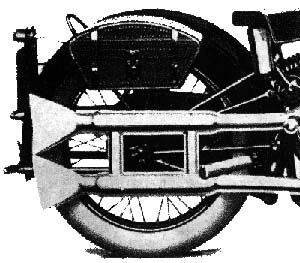



"I take great pleasure in owning my grandfather's Hurley-Pugh Wildebeeste Colonial MkI. This machine was reimported from the United States of America in 1992 and features the Pugh Catalysator Exhaust, probably the earliest known attempt to tame "harmful" vehicle emissions. Whilst most of these complex copper devices disappeared during the USA's Prohibition years, to be converted into stills, mine appears to be original and unmodified. As you will know, they burned graphited carbon within the baffle, to oxidise excessive hydrocarbons. I confess I have no idea how this should be initiated, and would very much appreciate your advice as to how I may use to advantage this visionary innovation."

The Pugh Patent Catalysor Exhaust System, as fitted to export models of the H-P Wildebeeste Colonial destined for the Confederate States, as Sir John preferred to call them. Note the panier water cistern to store supplies of phosphorus to ignite this unique and environmentally friendly device.
Well, I never thought I'd see one of these returned to our shores. My how we laughed at the time at the phrase "Emission Control" - jokes about the trouser department were as popular in the '30s as they are now. But funny how ideas will always come around. The biggest problem is replacing the carbon baffle insert. Unless you go to the expense of purchasing from British Nuclear Fuels, the only thing I can think of is to extract the lead out of 176 BB pencils and wire them together. This will make an insert of the correct diameter but 4" short of the original so an end-stop should be fabricated out of triple-glazed fireclay to retain the heat and keep the core in.
The ignition method was unique, requiring damp yellow phosphorus to be inserted into the fishtails. Kicking over for 15 minutes dried the pellets sufficiently for them to ignite spontaneously, and the collected petrol in the exhaust would then do the rest. Absurdly, yellow phosphorus is now thought of as dangerous, though it's quite safely kept in the toilet cistern. A reasonable substitute is the heads from 30-40 boxes of matches, but a piece of sandpaper glued to a long stick will be needed to set them off.
Just be sure to douse with a gallon of cold water when you arrive at your destination (check exhaust drain holes are clear). Once the pipes are glowing cherry-red, ease her off the stand and away you go, secure in the knowledge that you are saving the world and your Hurley-Pugh for your grandchildren.
"My old man popped his clogs a couple of years back leaving me his old beast of a Hurley-Pugh - a really rare one called a Wildebeeste Manxman Brooklands Bolton Hartlepool MkIV Prototype. The engine was a bit of gnarly metal alright, so I chopped it and it now looks pretty effin' cool with a 12" goosenecked and frenched Hungry Dawg lowrider frame, Old Don Blocksidge chisel engraving on the cases and all the brass thrunging sprocket thingies chromed and engraved with Satanic motifs. I swopped the tank for a low-tunnel Mustang Fastback Eldorado and am running 15" rear, 21" front with 24-over modded Pugh Patent Friction-Damped Forks, a high-level slash-cut pipe, 36" chrome sissy bar and black Alpaca fleece saddle cover, 666 Mark of the Beast rear light, a 6" Blaster headlight and 24" apes, all for the retro 1968 Bay Area look. One problem is that it bungs oil all over the back tyre. Are they supposed to do that, I thought it was just BSAs? It doesn't seem to be knackered, though it's dog-slow and sounds like a mixer full of scaffold clamps. Me mate gave us a plastic tank for the oil to collect in but a gallon every 6 miles is taking the piss. Can't I pump it around again? Another thing, why does it say 'Do not engage neutral whilst stationary' on the box? Take it easy."
Dear Mr Geezer, You would have done better not to write such a letter to this esteemed organisation. Now we know where you live. In the words of the graet "Killer" Steerforth: "You can run but you cannot hide."
For the benefit of bona-fide members, the Hurley-Pugh selection mechanism was never designed to select neutral with the engine running, the additional momentum of the coupled thrunging sprockets having been precisely calculated so as to allow for the lightweight 86 lb flywheel, whilst still ensuring smooth running. It is theoretically possible to put the machine into neutral with the engine running, but the additional vibration has been known to snap the downtubes. In any event, periods of idling such that the clutch cannot be comfortably held in with both hands, are liable to produce a hazardous puddle of waste lubricant. The correct procedure is to switch off the engine at traffic lights, etc.
previous article | next article